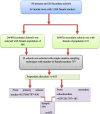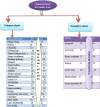Knowledge, attitude, and associated factor towards cervical cancer prevention among primary and secondary school female teachers in Gondar town, North West Ethiopia, 2022
- PMID: 37430287
- PMCID: PMC10332023
- DOI: 10.1186/s12905-023-02498-7
Knowledge, attitude, and associated factor towards cervical cancer prevention among primary and secondary school female teachers in Gondar town, North West Ethiopia, 2022
Abstract
Introduction: Cervical cancer is uncontrolled proliferation of cells on the cervix. Worldwide, millions of women suffer from this disease. Cervical cancer can be prevented by increasing awareness and changing negative attitude about the cause and prevention of cervical cancer. The aim of this study was to identify the gap of knowledge, attitude and associated factor about cervical cancer prevention.
Method: Institution-based cross-sectional study was conducted to collect data from 633 female teachers who were working in primary and secondary schools in Gondar town by using a stratified sampling technique. The collected data were checked for any inconsistency, coded, and entered by using EPI INFO version 7 and analyzed by using SPSS version 25. Both Bivariable and multivariable logistic regression analysis was computed to identify the association between the dependent variable with independent variables. Variables having P-value < 0.05 were considered statistically significant.
Result: The response rate of this study was 96.4% (610). Of these 38.4% (95% CI; 34.49-42.23) and 56.2% (95% CI; 52.28-60.18) of teachers had good knowledge and positive attitude on cervical cancer prevention respectively. Factors affecting teachers knowledge level were studied language [AOR; 3.9; (1.509-10.122)], Natural Science [AOR 2.9;( 1.128-7.475)], being married [AOR: 0.386; [95% (0.188-0.792)], and heard information from health professionals [AOR; 0.53(0.311-0.925)]. Working in secondary school [AOR; 1.83(1.03-3.25)], have regular menstrual period [AOR; 2.32(1.49-3.62)], no history of abortion, (AOR; 0.45(0.23-0.89), and good knowledge status (AOR, 2.56(1.64-4.00) were significantly associated with positive attitude.
Conclusion: Most of teacher's knowledge and attitude regarding to cervical cancer prevention were poor. Being married, the field of study, and natural science, heard information from health professionals were factors associated with knowledge. Working in secondary school, having regular menstrual period, no history of abortion, and good knowledge were factors associated attitude regarding to cervical cancer prevention. Therefore, enhancing health promotion through mass media and established counseling program with reproductive health is important.
Keywords: Attitude; Cervical cancer; Gondar; Knowledge; Prevention; Teachers.
© 2023. The Author(s).
Conflict of interest statement
The authors declare no competing interests.
Figures




Similar articles
-
Determinants of knowledge, attitude, and practice towards first aid among kindergarten and elementary school teachers in Gondar city, Northwest Ethiopia.BMC Emerg Med. 2021 Jun 21;21(1):73. doi: 10.1186/s12873-021-00468-6. BMC Emerg Med. 2021. PMID: 34154534 Free PMC article.
-
Knowledge, attitude and associated factors among primary school teachers regarding refractive error in school children in Gondar city, Northwest Ethiopia.PLoS One. 2018 Feb 15;13(2):e0191199. doi: 10.1371/journal.pone.0191199. eCollection 2018. PLoS One. 2018. PMID: 29447172 Free PMC article.
-
Knowledge, attitude and practice for cervical cancer prevention and control among women of childbearing age in Hossana Town, Hadiya zone, Southern Ethiopia: Community-based cross-sectional study.PLoS One. 2017 Jul 25;12(7):e0181415. doi: 10.1371/journal.pone.0181415. eCollection 2017. PLoS One. 2017. PMID: 28742851 Free PMC article.
-
Knowledge and willingness of parents towards child girl HPV vaccination in Debre Tabor Town, Ethiopia: a community-based cross-sectional study.Reprod Health. 2022 Jun 10;19(1):136. doi: 10.1186/s12978-022-01444-4. Reprod Health. 2022. PMID: 35689288 Free PMC article.
-
Comprehensive knowledge on cervical cancer, attitude towards its screening and associated factors among women aged 30-49 years in Finote Selam town, northwest Ethiopia.Reprod Health. 2018 Feb 14;15(1):29. doi: 10.1186/s12978-018-0471-1. Reprod Health. 2018. PMID: 29444689 Free PMC article.
Cited by
-
The edutainment program on knowledge, perception, and uptake of cervical cancer screening among Muslim women in Southern Thailand: a quasi experimental study.BMC Public Health. 2024 Jul 6;24(1):1803. doi: 10.1186/s12889-024-19287-y. BMC Public Health. 2024. PMID: 38971727 Free PMC article.
-
Knowledge and attitude toward cervical cancer screening among women aged 30-49 years attending selected health facilities in Ethiopia: Using structural equation model.Heliyon. 2024 May 21;10(10):e31596. doi: 10.1016/j.heliyon.2024.e31596. eCollection 2024 May 30. Heliyon. 2024. Retraction in: Heliyon. 2025 May 22;11(10):e43406. doi: 10.1016/j.heliyon.2025.e43406. PMID: 38831821 Free PMC article. Retracted.
-
Cervical Cancer Screening Practice and Associated Factors Among School Teachers in Bahir Dar City, North West Ethiopia: A Cross-Sectional Study.Health Sci Rep. 2024 Dec 24;7(12):e70295. doi: 10.1002/hsr2.70295. eCollection 2024 Dec. Health Sci Rep. 2024. PMID: 39720241 Free PMC article.
References
-
- de San josé S, Serrano B, Castellsagué X, Brotons M, Muñoz J, Bruni L, et al. Human papillomavirus (HPV) and related cancers in the global Alliance for vaccines and immunization (GAVI) countries: a WHO/ICO HPV information Centre report. Elsevier; 2012. - PubMed
MeSH terms
LinkOut - more resources
Full Text Sources
Medical
Miscellaneous

